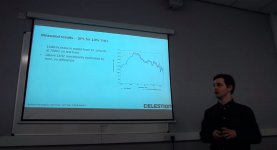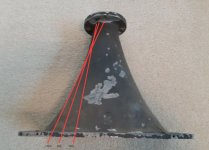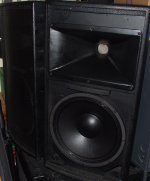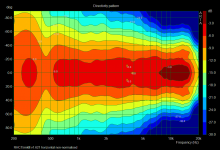Do you consider vertical axis beaming does really matter? As far as I understand, EQ can solve this issue.
It's always 'what's the application?' .....
Typical seated, home hi-fi sweet-spot, equilateral triangle, stereo setup....I doubt vertical pattern matters that much, other than getting the right tonality after room response piles on.
If you want more than seated, vertical obviously matters...
EQ cannot solve or really change the vertical pattern. (or horiz)
The best EQ or xover design can do pattern-wise, is change lobing patterns for particular listening heights. (assuming vertically stacked drivers).
EQ can only really change overall power response ime.... simply by shaping overall response.
Always the application (and preferences)...horses for courses
Stop use the term beaming. Its not clear and is a rookie statement. Time for you to express your desired directivity in both (all 3?) directions.
//
I love specificity!
The FB Celestion rep says that the xmax is 0.5mm and that xdamage is 1mm...he’s working on getting the Sd.
Last edited:
The FB Celestion rep says that the xmax is 0.5mm and that xdamage is 1mm...he’s working on getting the Sd.
If you love specificity, FB is probably not the best venue ;^).
Since the Axi2050 annular diaphragm at full excursion has no movement at the inner and outer edges of the Sd, you could figure displacement at roughly 1/2 of Sd multiplied by the excursion. However, the designer specifically mentioned excursion was linear to 1mm at the voice coil location, which conflicts with what you say the rep says.
I want to make sure that everyone understands what the acoustical impedance as shown above means and shows. In this example the device is not infinite, but finite, and the ripples (peaks and dips) are the result of a standing wave between the throat and the mouth. In this example the mouth reflection would have to be very large for this level of ripple.
If the waveguide is OS and the mouth is adequate terminate then these ripple will disappear. When they disappear the reactive component gets smoothed out and has much lower values. This means that the group delay will be much lower and, in fact, becomes virtually irrelevant.
When you see large ripples like this, you know that diffraction and reflections are excessive. One can also look to the drivers electrical impedance as these ripples will appear there as well, but not as clearly as they will appear in a pure acoustical; impedance.
In my waveguide there are no ripples at all in the electrical impedance, only the two peaks that are always present in a compression driver. Ripples always indicate a problem - they are never a good thing.
New horn vendor LMH
Anyone feel any type of way about elliptical tractrix horns? They claim they can ship to America...
Considering adding an e-tractrix to list of others I’ve accumulated
Is there a maximum excursion I should aim for? With a 350hz tractrix in HornResp I can create a flat response to about 400hz...then natural roll takes over...with a 2nd order LR at 400 it brings excursion to about .5mm at 117ish dB....is that fine?
Is there a maximum excursion I should aim for? With a 350hz tractrix in HornResp I can create a flat response to about 400hz...then natural roll takes over...with a 2nd order LR at 400 it brings excursion to about .5mm at 117ish dB....is that fine?
Totally agreed.
Narrowing directivity with increasing frequency is the fundamental issue. As fluid says, looking at the DI shows this best. Almost always, the narrowing directivity really increases in the top octave (i.e. 10 to 20 kHz.) It can be so narrow above 10 kHz the beam is like a pencil light width (1" diameter beam) focused at your ears. Move your head inches and there is a change in tone and a change in level. This is what is meant by "head in vice" listening position. Even with time alignment, I wonder how/what the image will integrate/sound like at 1 meter distance... Will be interesting to hear your results.
Mitch, as you undoubtedly know, this is true for many oldskool drivers, but not necessarily for modern designs.
The beam width in the top octave is primarily defined by the phase-plug and - if present - the the angle of the conical section.
Here's an example of a 3" diaphragm, 2" exit driver mounted on a short(ened) horn. The driver's exit angle is 34.7°.
Attachments
Last edited:
Considering adding an e-tractrix to list of others I’ve accumulated
Is there a maximum excursion I should aim for? With a 350hz tractrix in HornResp I can create a flat response to about 400hz...then natural roll takes over...with a 2nd order LR at 400 it brings excursion to about .5mm at 117ish dB....is that fine?
I don’t know if my question was translated-able lol...sorry I work looong hours.
Looking at Hf drivers, of the compression driver variety....taking advantage of the Axi’s strengths...trying to use a 350hz tuned horn down to 400hz....via eq...in HornResp I am able to create a flat response down to 400hz, then the natural roll off takes over...excursion climbs...adding a 2nd order high pass at ~400hz knocks out the excursion....the max excursion is ~0.5mm....at intended max volume ~117db....
My question is....should I be concerned with IMD?
I'd be more worried about my ears at 117 db
Of course, as you may know already, listening at lower volume with a high volume potential system equates into low distortion
So it sounds like my biggest concern is going to be mating this unique roll off with the 15 underneath. They work is shorter days in Saturday’s...probably because they don’t want to pay me 14 hours of overtime in one day...I’ll load my 2 frequency responses into VituixCAD and see if I can’t make a baby
The beam width in the top octave is primarily defined by the phase-plug and - if present - the the angle of the conical section.
I did not know this. Thank you.
I read through the first 20+ pages of posts (great discussion) and then skipped towards the end to see where things are at today.
@camplo Are you still working on building a 2way or are you improving on one you've already built?
It seems like even the best 2ways are enhanced with subwoofers, is the goal still only a 2way?
@camplo Are you still working on building a 2way or are you improving on one you've already built?
It seems like even the best 2ways are enhanced with subwoofers, is the goal still only a 2way?
I read through the first 20+ pages of posts (great discussion) and then skipped towards the end to see where things are at today.
@camplo Are you still working on building a 2way or are you improving on one you've already built?
It seems like even the best 2ways are enhanced with subwoofers, is the goal still only a 2way?
It became obvious that at least 3 channels of spectrum are a requirement for the best.
A 2 way plus sub?....a 3 way with a low crossover to bottom woofer?..
I finalized the design about the same time I started back to my seasonal career. I’ve contracted a company for the wood and cutting (Baltic birch) and have developed a horn with members here, and collected several other horns
For mixing/mastering purposes, I have theorized that a high amount of direct energy is desirable. The only way I know of to increase direct energy without turning up the volume knob is to increase driver surface area, horns, and directivity .
So my conclusion of (2 td18H+) + td15m + compression driver and horn (axi2050) is the result of this idea. High dynamic potential for un-compressed playback and low distortion. My first build will be with a manufactured horn (350hz Baltic birch e-tractrix) and I intend to 3D print horns that friends here designed for me.
- Home
- Loudspeakers
- Multi-Way
- Is it possible to cover the whole spectrum, high SPL, low distortion with a 2-way?



